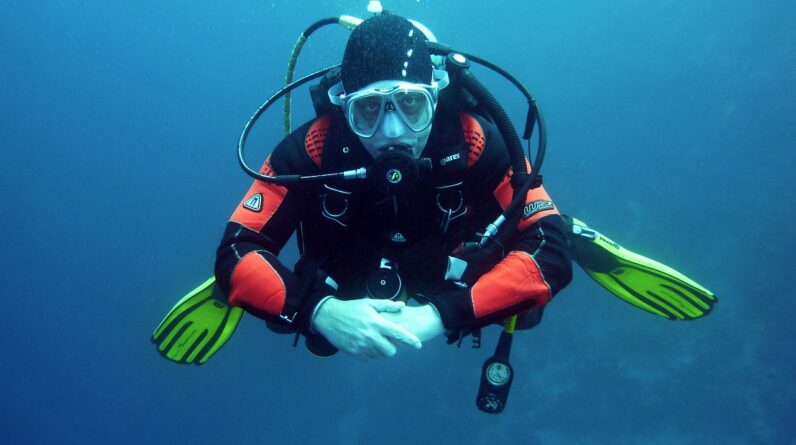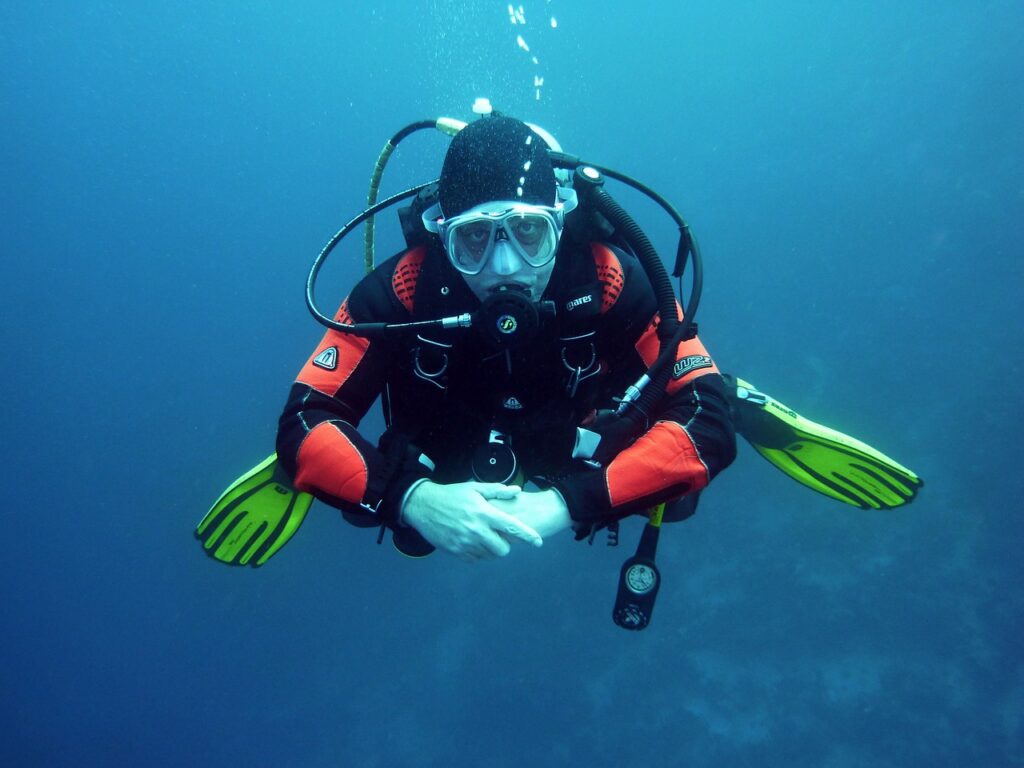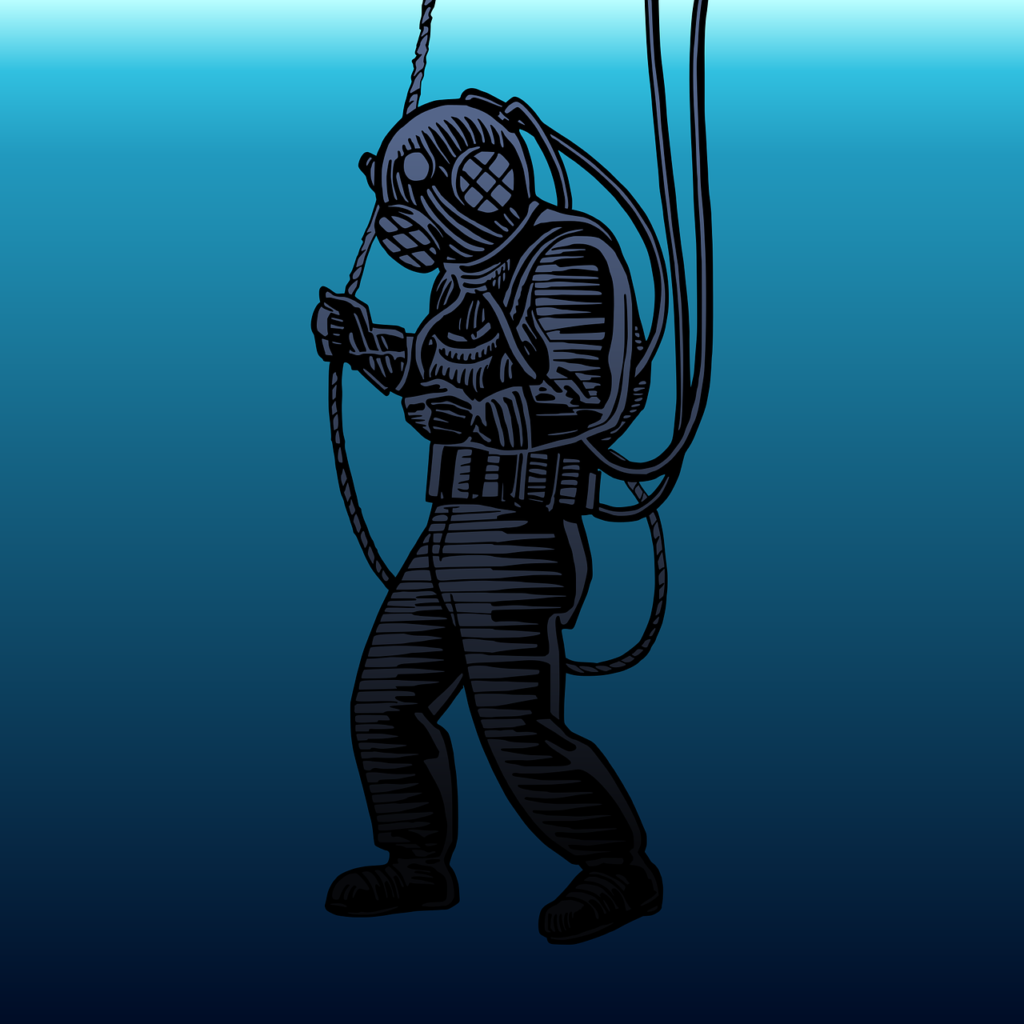
So you’ve taken the plunge and invested in a scuba diving exposure suit, also known as a dry suit, to enhance your underwater adventures. Bravo! But now comes the important question: how do you take care of and store this essential piece of gear? We’ve got you covered with the ultimate guide that will walk you through the dos and don’ts of caring for and storing your scuba diving exposure suit. From cleaning tips to proper storage techniques, this comprehensive guide will ensure that your suit stays in pristine condition, ready for your next dive. So let’s dive in and discover the best practices for keeping your scuba diving exposure suit in top-notch shape!
Cleaning Your Scuba Diving Exposure Suit
Rinsing Your Suit After Every Dive
After each dive, it is essential to rinse your scuba diving exposure suit thoroughly. This step helps remove any salt, sand, or debris that may have accumulated during your dive. Start by filling a basin or bathtub with fresh water and gently submerging your suit. Allow the water to flow through the suit, ensuring every part is rinsed, including the zippers, seals, and pockets. Avoid using hot water, as it may damage the suit’s material. Once rinsed, hang your suit to dry in a shaded area.
Washing Your Suit with Mild Detergent
In addition to rinsing, periodically washing your suit with a mild detergent will help maintain its cleanliness and prevent odor buildup. Fill a clean basin or bathtub with lukewarm water and mix in a small amount of a gentle, non-abrasive detergent. Submerge your suit in the soapy water and use a soft sponge or cloth to gently scrub the suit, paying extra attention to areas that may accumulate dirt or oils such as the neck and cuffs. Rinse the suit thoroughly afterward to remove any detergent residue.
Avoiding Harsh Chemicals
When cleaning your scuba diving exposure suit, it’s important to avoid using harsh chemicals such as bleach, solvents, or strong detergents. These chemicals can damage the suit’s material and degrade its waterproofing capabilities. Stick to mild detergents specifically designed for wetsuits or exposure suits, as they are formulated to clean effectively without causing harm.
Drying Your Suit Properly
Properly drying your scuba diving exposure suit is crucial to prevent the growth of mold and mildew. After washing or rinsing your suit, hang it to dry in a well-ventilated area away from direct sunlight. Avoid drying it on sharp or rough surfaces to prevent potential damage to the material. Make sure the suit is completely dry before storing it to maintain its integrity.
Storing Your Suit After Cleaning
After your scuba diving exposure suit is dry, it’s essential to store it properly to prolong its lifespan. Choose a cool, dry location with minimal exposure to sunlight. Hanging the suit on a wide hanger or storing it flat in a designated gear bag can help maintain its shape and prevent creases. To further protect your suit, consider using a mesh bag or separate storage for the hood, gloves, and boots to prevent damage and promote airflow. Regularly inspect and clean your storage area to keep it free from dust and debris.
Repairing Damage to Your Scuba Diving Exposure Suit
Identifying and Assessing Damage
Regular inspections of your scuba diving exposure suit are vital to identify any damage or wear. Look for signs of tears, holes, loose seams, worn zippers, or damaged velcro straps. Assess the severity of the damage and determine if it requires immediate repair or if it can be temporarily patched until professional repair can be arranged.
Patching Small Tears or Holes
For minor tears or small holes, you can patch your scuba diving exposure suit temporarily before professional repair. Clean the damaged area thoroughly and allow it to dry completely. Apply a suitable adhesive or patch designed for the specific suit material, following the manufacturer’s instructions. Ensure the patch covers the entire damaged area for a secure and watertight seal.
Replacing Zippers or Velcro
If the zippers or velcro on your scuba diving exposure suit are damaged beyond repair, replacement is necessary. Seek professional repair services or consult your suit’s manufacturer for recommendations. Replacing zippers or velcro should be done by experienced technicians to ensure proper installation and functionality.
Sealing Seams
Over time, the seams of your scuba diving exposure suit may become loose or start leaking. Sealing the seams can help maintain the suit’s integrity and waterproofing. Use a specialized seam sealer that matches your suit material and apply it evenly along the seams according to the manufacturer’s instructions. Allow sufficient drying time before using the suit.
Seeking Professional Repair
For significant damage or if you’re unsure of how to repair your scuba diving exposure suit, it’s best to seek professional repair services. Professional technicians have the expertise and proper tools to assess and repair various types of damage, ensuring the suit’s functionality and safety. Contact your suit’s manufacturer or reputable diving equipment shops for recommendations and assistance.

This image is property of pixabay.com.
Preventing Damage to Your Scuba Diving Exposure Suit
Avoiding Sharp Objects and Rough Surfaces
One of the best ways to prevent damage to your scuba diving exposure suit is to avoid contact with sharp objects and rough surfaces. When gearing up or removing your suit, be mindful of any sharp edges or abrasive surfaces that can puncture or scrape the material. Choose suitable areas for suiting up, away from potential hazards that can compromise the integrity of your suit.
Protecting from Sunlight and Extreme Temperatures
Exposure to direct sunlight and extreme temperatures can have detrimental effects on your scuba diving exposure suit. Prolonged exposure to sunlight can cause the material to fade, crack, or degrade. Extreme temperatures, whether hot or cold, can weaken the suit’s material and affect its flexibility. Store and transport your suit in a shaded, temperature-controlled environment to protect it from these elements.
Proper Handling and Donning
Improper handling and donning can lead to unnecessary strain and damage to your scuba diving exposure suit. Avoid stretching or pulling too forcefully on the suit, as this can weaken the material or cause tears. Take your time when donning the suit, ensuring a proper fit without overstretching or stressing the seams, zippers, or velcro.
Trimming Nails and Removing Jewelry
Long nails or sharp jewelry can accidentally tear or puncture your scuba diving exposure suit. Before putting on your suit, make sure to trim your nails short and remove any sharp jewelry that may come into contact with the material. This simple precaution can help prevent unnecessary damage and extend the lifespan of your suit.
Regularly Inspecting the Suit
Regular inspections are essential to catch any potential damage or wear before it worsens. Before and after each dive, visually inspect your scuba diving exposure suit for signs of tears, holes, loose seams, or damage to zippers and velcro. Promptly address any issues to prevent further damage and ensure the suit remains in good condition.
Storing Your Scuba Diving Exposure Suit
Choosing a Suitable Storage Location
Choosing the right storage location for your scuba diving exposure suit is crucial in maintaining its integrity. Select a cool, dry area away from direct sunlight and extreme temperatures. Avoid areas prone to high humidity or excessive moisture, as this can lead to mold or mildew growth. Consider using a dedicated gear bag or hanging system designed for scuba suits to keep it organized and protected.
Folding or Rolling Your Suit
When storing your scuba diving exposure suit, you have the option to fold or roll it. Folding can help maintain the suit’s shape, especially if it has built-in neoprene reinforcements or padding. However, if space is limited, rolling the suit can be a space-saving alternative. Whichever method you choose, ensure the suit is clean and dry before folding or rolling to prevent any trapped moisture or damage.
Using a Hanger or Drying Rack
Hanging your scuba diving exposure suit on a wide hanger or drying rack can help maintain its shape and prevent creases that can weaken the material. Choose a hanger or drying rack that supports the weight of the suit and evenly distributes it to avoid any stress points. Avoid using narrow or sharp-edged hangers that can damage the material or deform the suit.
Avoiding Compression Damage
Compressing your scuba diving exposure suit for extended periods can cause damage to the suit’s material and affect its overall functionality. Avoid placing heavy objects on top of the suit or storing it in a tightly packed space where it may become compressed. Maintaining proper airflow around the stored suit will help preserve its quality and prevent compression damage.
Separate Storage for Hood, Gloves, and Boots
To ensure optimal care for your scuba diving exposure suit and its accessories, consider storing the hood, gloves, and boots separately. These accessories may have different storage requirements and can potentially damage the suit if stored together. Use mesh bags or dedicated compartments within your gear bag to keep these items organized and prevent any contact that may cause unnecessary wear or tear.

This image is property of pixabay.com.
Transporting Your Scuba Diving Exposure Suit
Cleaning and Drying Before Transport
Before transporting your scuba diving exposure suit, it’s essential to clean and dry it thoroughly. Rinse the suit with fresh water to remove any salt, sand, or debris. Allow it to dry completely in a well-ventilated area away from direct sunlight. Transporting a clean and dry suit not only maintains good hygiene but also prevents any potential damage or odor buildup during transit.
Protecting the Suit During Transport
To protect your scuba diving exposure suit during transport, it’s advisable to use a padded gear bag. A padded gear bag provides cushioning and prevents excessive pressure or impact that can potentially damage the suit. Make sure the suit is properly stored within the bag and secured to prevent shifting or unnecessary stress on the material.
Using a Padded Gear Bag
When choosing a padded gear bag for transporting your scuba diving exposure suit, look for one specifically designed for this purpose. These bags typically have reinforced padding, durable materials, and compartments for other diving gear. Ensure the gear bag has sufficient space to accommodate your suit without excessive folding or compression.
Avoiding Extra Weight or Pressure
When transporting your scuba diving exposure suit, avoid adding unnecessary weight or pressure on top of the suit. Heavy objects or other gear can potentially deform the suit, compromise its waterproofing, or cause damage to delicate parts such as zippers or seals. Keep the transported suit separate from other equipment to maintain its integrity.
Consideration for Air Travel
If you plan to transport your scuba diving exposure suit by air, it’s essential to check with the airline regarding their policies and guidelines. Some airlines may require specific packaging or have restrictions on carrying diving equipment. Additionally, be prepared to handle your suit with care during security screenings to avoid any damage caused by rough handling.
Extending the Lifespan of Your Scuba Diving Exposure Suit
Proper Maintenance and Inspection
Regular maintenance and inspection of your scuba diving exposure suit are crucial to extending its lifespan. Follow the cleaning, drying, and storing guidelines outlined earlier in this guide. Additionally, inspect the suit before and after each dive, addressing any damage promptly. By taking these preventative measures and promptly addressing any issues, you can ensure your suit remains in good condition for an extended period.
Not Overusing or Overexposing
Overusing or overexposing your scuba diving exposure suit can lead to accelerated wear and tear. While exposure suits are designed to withstand the underwater environment, excessive use or exposure to harsh conditions can result in premature aging or damage. Rotate your scuba diving exposure suit with other suits if you dive frequently, giving each suit time to rest and recover.
Avoiding Chemical Exposure
Chemicals such as harsh detergents, solvents, or petroleum-based products can damage your scuba diving exposure suit. Avoid contact with these substances and be mindful of the cleaning products you use. Stick to mild detergents specifically formulated for exposure suits, ensuring they are suitable for your suit’s material. Rinse the suit thoroughly after cleaning to remove any residue.
Following Manufacturer’s Guidelines
Each scuba diving exposure suit may have specific care and maintenance instructions provided by the manufacturer. It is crucial to familiarize yourself with these guidelines and adhere to them closely. The manufacturer’s recommendations are tailored to the specific suit and material, ensuring the best care practices for longevity and performance.
Replacing when Necessary
No matter how well-maintained and cared for, scuba diving exposure suits have a finite lifespan. Over time, wear, tear, and degradation are inevitable. When your suit begins to show signs of significant damage or deterioration, it’s time to consider replacing it. Continuing to use a compromised suit can affect its safety and performance, potentially putting you at risk during dives.

This image is property of pixabay.com.
Choosing the Right Scuba Diving Exposure Suit
Understanding Different Suit Types
Scuba diving exposure suits come in a variety of types, each catering to specific diving conditions and personal preferences. The three main types are wetsuits, drysuits, and semi-drysuits. Wetsuits provide thermal insulation through neoprene material, allowing a thin layer of water to enter and be warmed by the diver’s body heat. Drysuits, on the other hand, keep the diver dry by preventing water from entering, relying on specialized seals. Semi-drysuits combine features of both wetsuits and drysuits, providing some insulation and minimal water entry.
Considering Water Temperature and Depth
When choosing a scuba diving exposure suit, it’s essential to consider the water temperature and depth you’ll be diving in. Wetsuits are suitable for warmer waters, while drysuits are more appropriate for colder temperatures and extended exposure. If you anticipate diving in a wide range of temperatures, a versatile suit or layering system that allows for adjustments is recommended.
Fit and Comfort
Proper fit and comfort are paramount when selecting a scuba diving exposure suit. Ill-fitting suits can result in limited mobility, discomfort, and potential exposure to water. Pay attention to the suit’s sizing chart and try it on before making a purchase. A snug yet comfortable fit is important to minimize water ingress and ensure optimal thermal insulation.
Material Durability
The durability of the suit’s material plays a significant role in its longevity. Look for scuba diving exposure suits made from high-quality materials that can withstand the demands of diving. Neoprene, crushed neoprene, trilaminate, and membrane are common materials used in exposure suits. Each material has its own advantages, such as flexibility, insulation, or resistance to compression. Consider your diving conditions and personal preferences when choosing a suit material.
Extras and Customization Options
Scuba diving exposure suits may come with various extras and customization options. These can include reinforced knees, built-in hoods, or additional pockets for storage. Assess your personal needs and preferences to determine which extras or customization options are essential for your diving activities. However, be mindful that additional features may come with additional costs and potentially affect the suit’s overall fit or performance.
Cleaning and Maintaining Specific Suit Materials
Neoprene Suits
Neoprene suits are one of the most commonly used suit materials in scuba diving exposure suits. To clean and maintain neoprene suits, follow the steps outlined earlier in this guide for rinsing and washing with mild detergent. Avoid prolonged exposure to direct sunlight, as neoprene can degrade and lose its elasticity over time. Additionally, regularly inspect the suit for any signs of deterioration, such as cracks or tears, and promptly address any issues.
Crushed Neoprene Suits
Crushed neoprene suits have a unique texture that requires special care. When cleaning crushed neoprene suits, follow the same rinsing and washing steps as for neoprene suits but use extra caution. The crushed texture can trap dirt or debris, so thorough cleaning is necessary. Gently scrub the suit using a soft sponge or brush, ensuring all crevices are cleaned. Avoid aggressive scrubbing as it can damage the texture of the suit.
Trilaminate and Hybrid Suits
Trilaminate and hybrid suits are made from lightweight and durable materials, designed to withstand diverse diving conditions. To clean and maintain trilaminate and hybrid suits, follow the same rinsing and washing steps as for other suit materials. Pay attention to any specific care instructions provided by the manufacturer, as some trilaminate or hybrid suits may require special care or specific cleaning products.
Membrane Suits
Membrane suits are highly technical and typically made from a thin, waterproof fabric. Cleaning and maintaining membrane suits may require specialized care. Consult the manufacturer’s guidelines for specific instructions, as membrane suits often have unique cleaning requirements. Treat membrane suits gently and avoid exposure to harsh chemicals or solvents that can compromise the suit’s waterproofing properties.
Choosing the Right Cleaning Products for Each Material
Choosing the right cleaning products for each suit material is essential to prevent potential damage. Always opt for mild detergents specifically formulated for exposure suits or follow the manufacturer’s recommended cleaning products. Avoid using aggressive or abrasive cleaners that can degrade the material or affect its functionality. When in doubt, consult the manufacturer or a reputable diving equipment shop for guidance on suitable cleaning products for your specific suit material.
Tips for Donning and Doffing Your Scuba Diving Exposure Suit
Preparation for Donning the Suit
Before donning your scuba diving exposure suit, ensure you are in a clean and dry environment. Remove any sharp objects or potential hazards that may damage the suit. Take the time to inspect the suit for any visible damage or tears. It’s also a good practice to warm up your body before donning the suit to increase flexibility and ease of wearing.
Ensuring a Proper Fit
Achieving a proper fit is crucial for the comfort and functionality of your scuba diving exposure suit. Start by finding the right size suit based on the manufacturer’s sizing chart. Take your time when putting on the suit, ensuring it is snug but not overly tight. Pay attention to areas such as the wrists, ankles, and neck, which should have a good seal without restricting blood circulation.
Using Lubricants or Soaps
Using lubricants or soaps can assist in donning your scuba diving exposure suit, especially with drysuits or semi-drysuits. There are specialized lubricants available that are water-based and won’t damage the suit. Apply a small amount to your skin or the suit’s interior to help in sliding on the suit smoothly. Avoid using petroleum-based products that can degrade the suit’s material.
Proper Techniques for Donning and Doffing
Learning and practicing proper techniques for donning and doffing your scuba diving exposure suit can make the process more efficient and reduce the risk of damage. When donning, start by slowly sliding your limbs into the suit, avoiding sudden or forceful movements. Use a gentle pulling or rolling motion to gradually work the suit up your body. When doffing, reverse the process by starting from the neck and working your way down to the ankles. Take your time and avoid rushing, as haste can lead to accidental tears or damage.
Preventing Tears or Damage while Donning
To prevent tears or damage while donning your scuba diving exposure suit, it is important to take precautions. Trim your nails short to minimize the risk of inadvertently puncturing or tearing the suit. Avoid wearing sharp jewelry or accessories that can snag or scrape the material. Additionally, be mindful of any potentially sharp or rough surfaces in your environment that can damage the suit during the donning process.
Storing and Maintaining Zippers, Velcro, and Seals
Cleaning and Lubricating Zippers
The zipper is a vital component of your scuba diving exposure suit and requires proper maintenance. After each dive, rinse the zipper with fresh water to remove any salt or debris. Periodically, clean the zipper more thoroughly using a soft brush or cloth to remove any buildup. Lubricate the zipper with a specialized zipper wax or silicone spray recommended by the manufacturer to ensure smooth operation.
Regularly Inspecting Velcro Straps
Velcro straps are commonly used in scuba diving exposure suits for adjustable closures. Regularly inspect the velcro straps for any signs of wear, fraying, or deterioration. Ensure the velcro is clean and free from debris, as dirt or sand particles can hinder its adhesive strength. Replace any worn or damaged velcro straps promptly to maintain the suit’s proper closure and fit.
Maintaining Seals and Ensuring a Proper Seal
Seals, such as neck and wrist seals in drysuits, are essential for maintaining a proper seal and preventing water entry. Inspect the seals before each dive for any signs of wear, cracking, or damage. Clean the seals regularly with fresh water and avoid excessive exposure to direct sunlight or harsh chemicals that can degrade the material. If the seals become compromised or lose their effectiveness, seek immediate replacement or professional repair.
Replacing or Repairing Damaged Zippers, Velcro, or Seals
If your scuba diving exposure suit’s zippers, velcro, or seals are damaged beyond repair, it is crucial to address the issue promptly. Damaged zippers or velcro can compromise the suit’s waterproofing, while worn or torn seals can allow water entry. Seek professional repair services or consult the suit’s manufacturer for recommendations on replacing or repairing these damaged components.
Using Zipper Wax or Silicone Spray
To maintain the smooth operation of zippers, applying specialized zipper wax or silicone spray is recommended. These products help lubricate the zipper, reduce friction, and prevent corrosion. Follow the manufacturer’s instructions for proper application and avoid using excessive amounts that can attract dirt or debris.
Proper care and maintenance of your scuba diving exposure suit are essential to ensure its durability, functionality, and safety. Following these guidelines will help you keep your suit in top condition, prevent unnecessary damage, and extend its lifespan. Remember to always refer to the manufacturer’s instructions and seek professional assistance when needed. With proper care, your scuba diving exposure suit will continue to serve you well on your underwater adventures.






